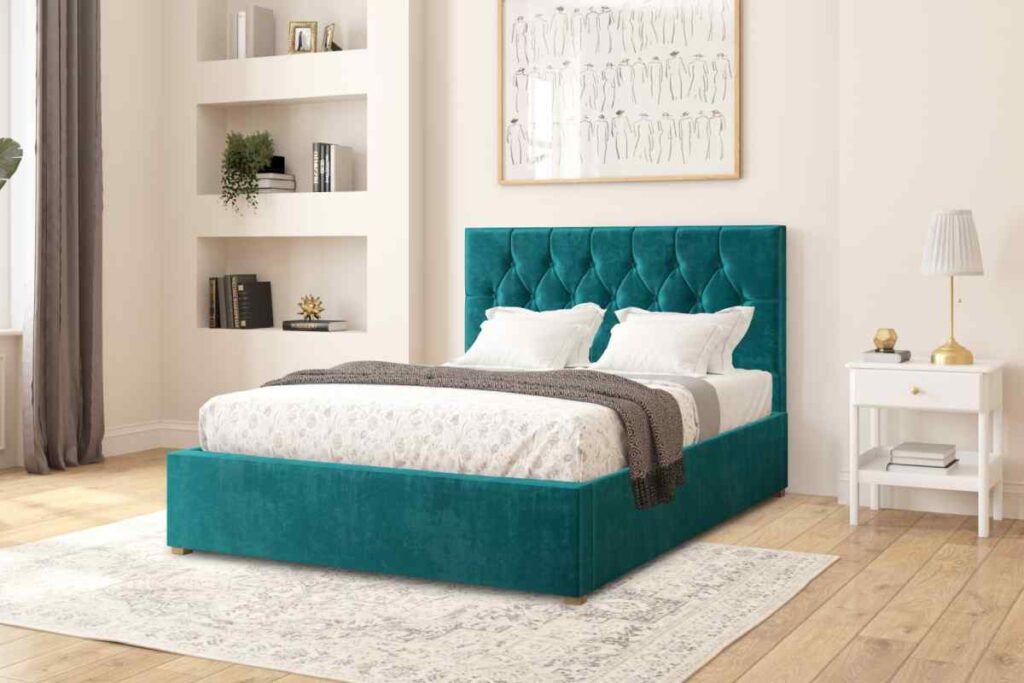Creating a serene and harmonious bedroom starts with thoughtful color coordination between your walls and bedding. The wall color sets the substance for the entire room’s atmosphere, while your bedding choices can either enhance or detract from the desired mood. Using the 60-30-10 rule helps achieve balance, with 60% of the space dedicated to the main wall color, 30% for bedding, and 10% for decorative accents.
Color choices significantly impact the emotional atmosphere of a bedroom. A well-coordinated palette promotes relaxation and tranquility, transforming your sleeping space into a peaceful retreat. When selecting bedding, consider both the wall color and the room’s lighting to create a cohesive design that supports restful sleep.
Mixing patterns and textures adds depth while maintaining color harmony. Bedding accessories like pillows, throws, and a bedskirt can add flare to an ottoman style bed, creating a polished look that reflects professional interior design principles.
Key Takeaways
- The 60-30-10 rule creates perfect balance between walls, bedding, and accessories
- Strategic color coordination promotes relaxation and enhances sleep quality
- Layering textures and patterns adds visual interest while maintaining color harmony
Understanding Color Dynamics in Bedroom Design
Colour choices in bedroom design create powerful psychological and visual effects that shape the entire living space. Properly coordinated colours between walls and furnishings establish harmony while influencing mood and atmosphere.
The Role of Wall Colour in Setting Mood and Tone
Wall colour serves as the foundation of bedroom design. Light blues and soft greens promote relaxation and tranquility, perfect for generating a peaceful sleep environment.
Deep, rich colours like navy or burgundy add sophistication and warmth. These darker shades work best in spacious rooms with ample natural light.
Neutral walls in beige, grey, or cream offer versatility in decorating. They allow for easy updates through accent pieces and bedding without requiring complete room makeovers.
Selecting a Colour Scheme: Tools and Principles
The colour wheel guides effective palette creation. Complementary colours sit opposite each other, creating dynamic disparities – like blue and orange or purple and yellow.
Analogous schemes use three adjacent colours on the wheel, producing gentle transitions. A blue-green-teal combination creates a serene coastal feel.
Monochromatic schemes employ various tints and shades of one colour. Light grey walls paired with charcoal bedding and silver accessories create sophisticated depth.
The Psychological Impact of Colour Choices
Cool tones like blue and green reduce stress and lower blood pressure. These colours prove ideal for bedrooms focused on rest and recovery.
Warm hues such as soft yellow or pale coral energize the space. They work well in morning-lit rooms where natural awakening is desired.
Neutral colours provide mental clarity and balance. Beige, taupe, and cream create a clean canvas that promotes mental relaxation.
White spaces enhance feelings of cleanliness and order. Layering different textures in white prevents the room from feeling sterile.
Coordinating Bedding and Accessories for a Cohesive Look
Creating a harmonious bedroom starts with selecting the right bedding elements and accessories that complement each other while reflecting personal style.
Choosing Bedding: Merging Comfort with Style
Select a duvet cover or comforter as the central focal point. This piece sets the tenor for the entire room’s colour scheme.
Pair solid-coloured sheets with patterned bedding, or vice versa. This creates visual interest without overwhelming the space.
Consider these pattern combinations:
- Florals with stripes
- Geometric prints with solids
- Small patterns with larger designs
Choose microfiber bedding for durability and easy maintenance. The material works well in any season and maintains its appearance through multiple washes.
Accessorizing with Purpose: Pillows, Curtains, and More
Layer throw pillows in complementary colours and varying sizes. Three to five pillows create an inviting arrangement without cluttering the bed.
Match curtain fabrics to secondary colours in the bedding. This creates flow between window treatments and bed linens.
Select artwork that incorporates colours from your bedding palette. Position pieces at eye level for maximum impact.
Place an area rug that ties together the room’s colour scheme. The rug should extend beyond the bed’s edges by at least 45 centimetres.
Lighting and Texture: The Finishing Touches
Install bedside lamps with bases that complement your colour scheme. Warm-toned bulbs create a cosy atmosphere.
Mix textures thoughtfully:
- Smooth cotton sheets
- Quilted coverlets
- Chunky knit throws
- Velvet accent pillows
Add metallic elements through picture frames or lamp finishes. These details reflect light and add sophistication to the space.
Choose nightstand accessories in colours that echo the bedding palette. Small trays, books, or decorative objects can reinforce the colour scheme.
Conclusion
Coordinating bedroom walls with bedding creates a polished, unified design scheme. The 60-30-10 rule provides a reliable framework, with walls typically representing the dominant 60% and bedding serving as the 30% secondary colour.
Successful bedroom colour coordination depends on thoughtful consideration of room size, natural lighting and existing furniture. Testing fabric swatches against wall colours before making final decisions helps ensure harmonious results.
The right combination of wall colour and bedding transforms a bedroom into a cohesive, welcoming space that reflects personal style while maintaining visual balance.


